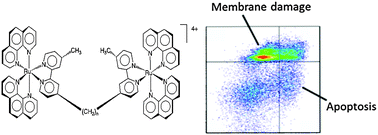Biological processing of dinuclear ruthenium complexes in eukaryotic cells
Abstract
The biological processing – mechanism of cellular uptake, effects on the cytoplasmic and mitochondrial membranes, intracellular sites of localisation and induction of reactive oxygen species – of two dinuclear polypyridylruthenium(II) complexes has been examined in three eukaryotic cells lines. Flow cytometry was used to determine the uptake of [{Ru(phen)2}2{μ-bb12}]4+ (Rubb12) and [Ru(phen)2(μ-bb7)Ru(tpy)Cl]3+ {Rubb7-Cl, where phen = 1,10-phenanthroline, tpy = 2,2′:6′,2′′-terpyridine and bbn = bis[4(4′-methyl-2,2′-bipyridyl)]-1,n-alkane} in baby hamster kidney (BHK), human embryonic kidney (HEK-293) and liver carcinoma (HepG2) cell lines. The results demonstrated that the major uptake mechanism for Rubb12 and Rubb7-Cl was active transport, although with a significant contribution from carrier-assisted diffusion for Rubb12 and passive diffusion for Rubb7-Cl. Flow cytometry coupled with Annexin V/TO-PRO-3 double-staining was used to compare cell death by membrane damage or apoptosis. Rubb12 induced significant direct membrane damage, particularly with HepG2 cells, while Rubb7-Cl caused considerably less membrane damage but induced greater levels of apoptosis. Confocal microscopy, coupled with JC-1 assays, demonstrated that Rubb12 depolarises the mitochondrial membrane, whereas Rubb7-Cl had a much smaller affect. Cellular localisation experiments indicated that Rubb12 did not accumulate in the mitochondria, whereas significant mitochondrial accumulation was observed for Rubb7-Cl. The effect of Rubb12 and Rubb7-Cl on intracellular superoxide dismutase activity showed that the ruthenium complexes could induce cell death via a reactive oxygen species-mediated pathway. The results of this study demonstrate that Rubb12 predominantly kills eukaryotic cells by damaging the cytoplasmic membrane. As this dinuclear ruthenium complex has been previously shown to exhibit greater toxicity towards bacteria than eukaryotic cells, the results of the present study suggest that metal-based cationic oligomers can achieve selective toxicity against bacteria, despite exhibiting a non-specific membrane damage mechanism of action.


 Please wait while we load your content...
Please wait while we load your content...